Category: General

Mercedes-Benz Vision V name confirmed for electric van concept
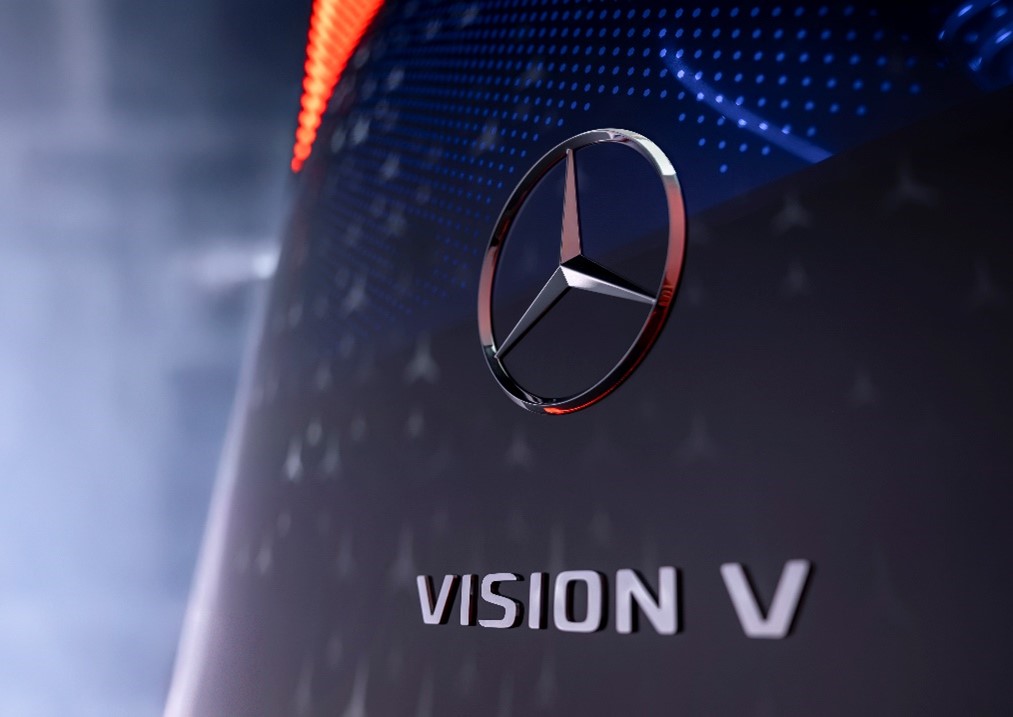
Mercedes-Benz on Monday announced that its upcoming electric van concept will be called the Vision V.
We’re still far away from the debut of this concept, which is expected to be revealed later this spring, but Mercedes has already teased that the Vision V will preview its Van.EA modular architecture for future electric vans.
The first vans based on this architecture are scheduled to enter production in 2026, and Mercedes confirmed last October that prototypes were out testing. The automaker aims to offer these vans in a number of configurations, including a U.S.-bound electric luxury van and a potential RV, alongside basic passenger and cargo vans.
Unlike the current Mercedes-Benz eSprinter, which houses an electric powertrain in a fairly standard van shell, Van.EA was designed from the start to accommodate EVs—with high levels of modularity. Mercedes has said the platform is split into three main blocks, with front and rear blocks that can each house electric motors for single-motor or dual-motor configurations. Van.EA models are expected to be front-wheel drive in single-motor form.
Mercedes previously indicated that all of future vans would be based on the Van.EA architecture, but last month it reversed course, announcing a “second variant of the architecture” called Van.CA for internal-combustion models.
Van.CA and Van.EA models will share 70% of parts, and will be built on the same assembly lines, Mercedes said at the time. So while the balance of power may have shifted to EVs, with the combustion-engine architecture now derived from the electric architecture, instead of the other way around, it appears Mercedes is planning for more tailpipes than previously thought.

Florida is second only to California in EV sales: How’d that happen?
Florida’s politics are the polar opposite of California’s. Yet the home state of President Trump is second only to California in EV sales.
That sales growth, leaving Florida solidly in the top position after California, based on cumulative EV registrations, was driven not by incentives but primarily by EV enthusiasm in the populous central region of Florida. More than 17,000 EVs were newly registered in the nine counties of Central Florida between November 2023 and November 2024, according to a recent examination of this sales trend by the Orlando Sentinel.

2025 Volkswagen ID.4
For the full year of 2024, Central Florida’s EV registrations grew 15.2%, surging past the national average of 9.4%. And registrations in EVs in Orange County, where Orlando is, surged 46% year-over-year. It’s an acceleration of a trend that’s been going on for years now. Florida is an anomaly and, like Texas, it’s posted relatively strong EV growth over the years without significant state incentives.
In 2023 and 2024 EV adoption continued to become more polarized by state. That may also be happening on a local level in Florida, which isn’t as homogeneous as it appears.
The rest of the country tends to see Florida as full of retirees, but even by 2030, official state projections suggest that people aged 65 and up won’t be the largest demographic group in the state. That leaves more room for Gen X and Millennials, who previous studies have shown tend to buy more EVs than Boomers, while the latter group controls policy decisions related to them.
And while the state government hasn’t exactly been pro-EV, that hasn’t stopped efforts to expand charging infrastructure in Florida. In 2022, Invisible Urban Charging (IUC) announced plans to install 6,000 chargers—doubling the number of chargers in the state. The chargers are primarily 80-amp Level 2 AC units for public spaces and housing developments, IUC said at the time.

Airstream launches electric travel trailer for off-grid adventures
Airstream on Saturday unveiled its first all-electric travel trailer, which can use battery power to operate off the grid.
Called the Airstream Basecamp 20Xe, the trailer includes a 10.3-kwh battery pack and 3,000-watt inverter powering a 30-amp electrical system, providing onboard power for charging devices from built-in outlets, as well as running an optional air-conditioning system or microwave. A standard induction cooktop powered by a 110-volt outlet can be used inside or outside the trailer.
A 600-watt rooftop solar array provides supplementary power. The trailer also comes pre-wired for an additional 300 watts of solar-generating capacity, and includes a 20-pound propane tank that can be used for interior heating and hot water, as well as outdoor grilling. Heating can be done using only electricity, only propane, or a combination of the two.
An optional composting toilet helps conserve water, as does a recirculating feature that redirects cold water from the heater into the freshwater tank until it reaches the proper temperature.
The trailer’s 20-foot floorpan includes a dedicated sleeping space at the back and a convertible dinette up front. It’s also equipped with standard 3-inch lift, chunky tires, and stone guards for off-road use, as well as storage space within its teardrop shroud bodywork.

Airstream eStream electric camping trailer
Missing from Airstream’s announcement, however: There is no mention of using the battery pack to help propel the trailer and reduce the range loss of electric tow vehicles, or improve the fuel economy of internal-combustion tow vehicles, as with eStream concept Airstream unveiled in 2022. That idea has been taken up by startups Pebble and Lightship for use in their luxury travel trailers, both of which are scheduled to start production later this year.

2025 Ford E-Transit electric van aims for electricians
The 2025 Ford E-Transit—an all-electric version of the automaker’s Transit van—receives some new options while holding steady on pricing.
An E-Transit cargo van costs $51,000 before destination—about the same as a 2024 model. Ford also offers chassis cab and cutaway versions priced at $46,200 and $45,700 before destination, respectively.
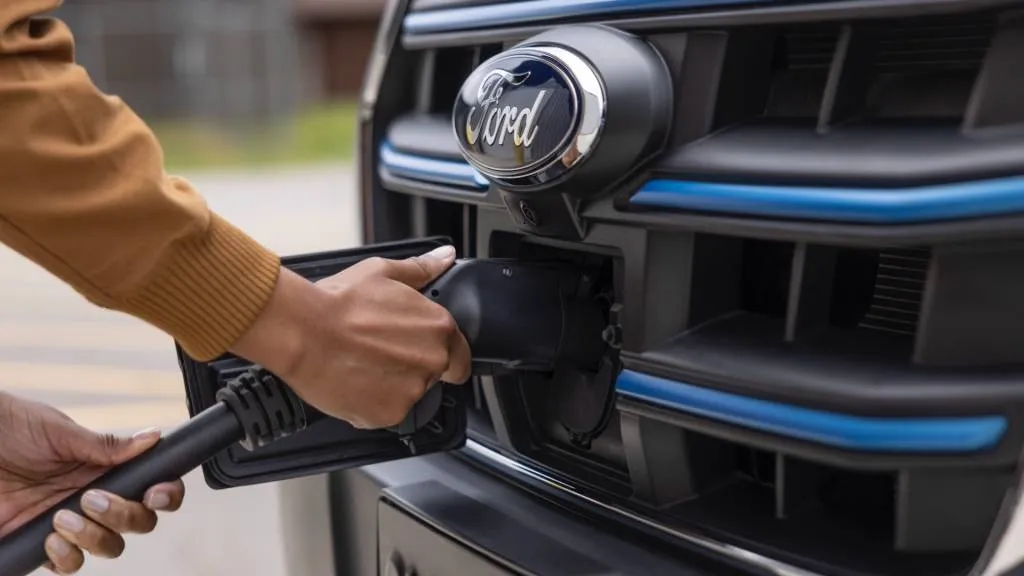
2025 Ford E-Transit
New for 2025 are four option packages aimed at specific trades. These include electrician ($4,370) HVAC ($4,440), and general contractor ($2,900) packages, as well as a $3,300 folding-shelving package with large shelves intended for delivery services.
Ford introduced the E-Transit for the 2022 model year, and upgraded it with a bigger battery pack for 2024. Those changes carry over for 2025, meaning the E-Transit continues with an 89-kwh pack affording up to 159 miles of EPA-cycle range. That pack powers a single electric motor, which sends 266 hp and 317 lb-ft of torque to the rear wheels.

2025 Ford E-Transit
Expect unchanged peak DC fast-charging power of up to 176 kw, allowing the E-Transit to replenish 67 miles of range in 15 minutes, using a 180-kw charger. The E-Transit can also make use of an 80-amp Level 2 AC wallbox for a 6-hour, 11-minute, full recharge, as well as export up to 2.4 kw with its Pro Power Onboard system, shared with the F-150 Lightning EV as well as hybrid versions of the F-150 truck.
The E-Transit competes against electric versions of some of the same vans the standard Ford Transit fights with for fleet sales, including the Mercedes-Benz eSprinter and Ram ProMaster EV. Rivian also recently opened up sales of its electric van, originally designed for Amazon, to all fleets. And General Motors leverages its EV architecture for the BrightDrop electric vans, which were recently folded into the Chevrolet brand.

2025 Volvo EX90 EV gets $10,000 discount for Costco members
Costco members who lease a 2025 Volvo EX90 electric SUV can now take advantage of the biggest discount offered by the retailer’s auto program.
Fellow Internet Brands site CarsDirect found a potential $10,000 in savings for Costco members who are also current Volvo customers, and are planning to lease a new EX90 between now and Apr. 30.
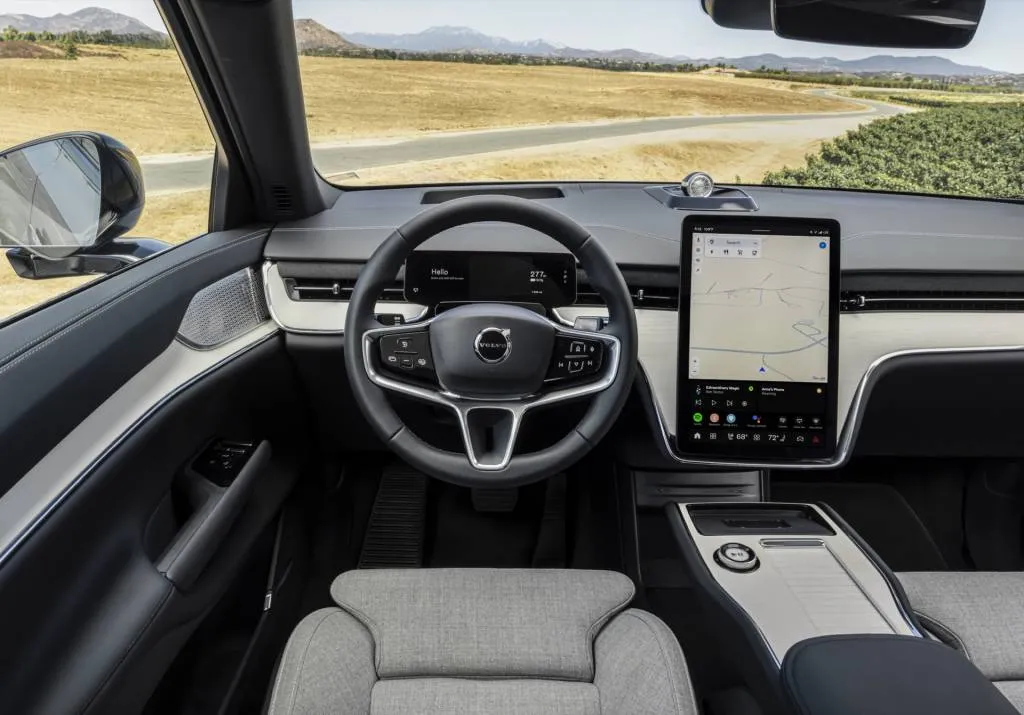
2025 Volvo EX90
This starts with $2,000 just for being a Costco Executive member, or $1,500 for Gold Star and Business members. Lower incentives of $1,250 for Executive members and $1,000 for Gold Star and Business members are also currently available for several General Motors EVs, according to the Costco website. Those eligible models include the Chevrolet Blazer EV, Equinox EV, and Silverado EV, as well as the GMC Hummer EV and Sierra EV.
That discount can be combined with a $500 loyalty discount for returning customers and a $7,500 EV lease incentive from Volvo, likely an application of the EV leasing loophole that allows manufacturers with captive leasing arms to take a $7,500 credit and pass the savings on to a customer.
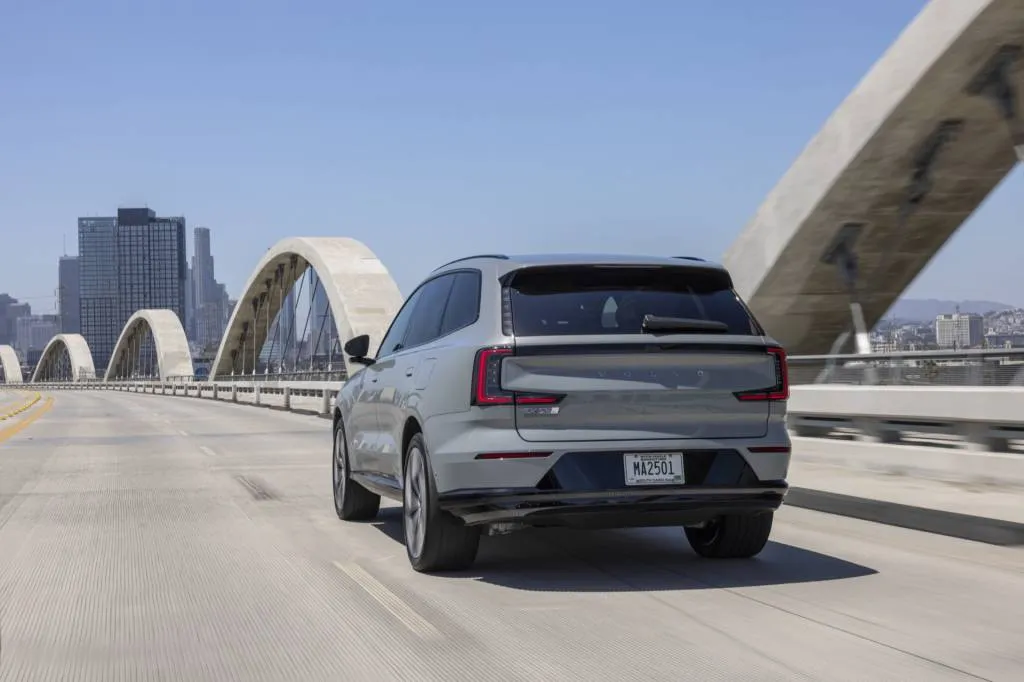
2025 Volvo EX90
The EX90 might qualify for a lease credit, but it doesn’t yet qualify for the $7,500 purchase credit. The EX90 is U.S. built, and is priced just under the ceiling for the credit, meeting some qualifications, but not all of them.
Costco has offered its discount EV program for some time, but it only in recent months jumped back into EV charging. Costco was one of the first big-box retailers to offer charging, installing Level 2 chargers at some California locations in the 1990s. It pulled the plug on those stations in 2011 and 2012, but last year resumed installing DC fast chargers while keeping its profitable gas pumps.

Jeep or Ram might use EV drive motor to power integrated winch
Winches are a vital off-road accessory. And while they’re typically powered by a vehicle’s 12-volt electrical system, Stellantis is looking at an alternative power source for them in hybrids and electric vehicles.
In a patent filing published by the United States Patent and Trademark Office (USPTO) Jan. 21, 2025, and submitted by the automaker about a year prior, Stellantis discusses running a winch not off a battery pack but with a gearbox connected to one of the vehicle’s electric drive motors.
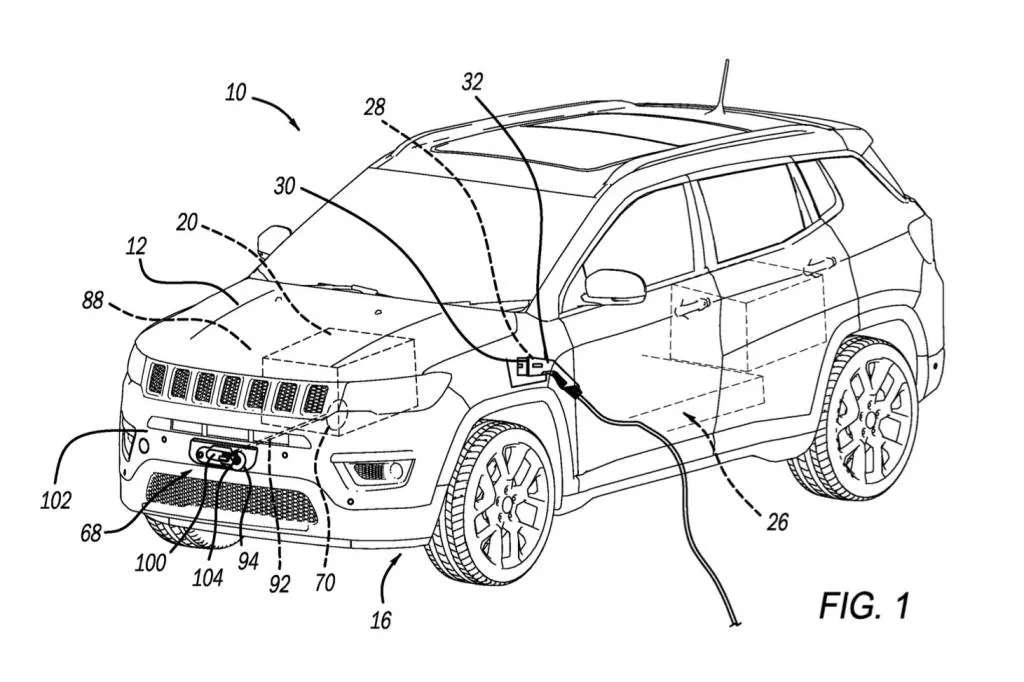
Stellantis patent image of a winch geared to an electric motor
As described in the document, the winch would be mounted on a vehicle’s front bumper in the conventional fashion. But instead of having its own built-in electric motor to spool and unspool a cable (which is then connected to an anchor point to pull the vehicle out of trouble spots), the winch would be connected to a planetary gearbox and then to drive modules like the ones Stellantis plans to manufacture in Indiana.
The gearbox would in turn be connected to the differential on the front axle, allowing an electric motor normally used to propel the vehicle to turn the winch’s spool instead of the wheels. A winch mode would disconnect the front wheels, as well as activate the parking brake to lock the rear wheels for maximum stability, according to the filing.
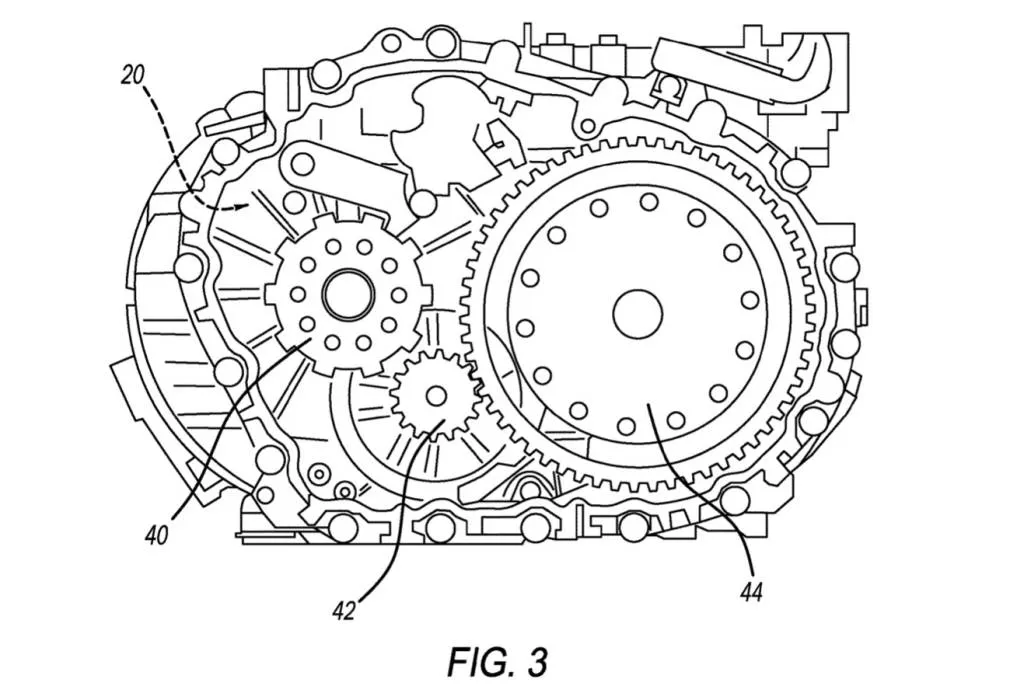
Stellantis patent image of a winch geared to an electric motor
The main benefit of such an arrangement would likely be the ease of integrating winches into vehicles from the factory. Eliminating the dedicated motor for winches would make them more compact, and potentially easier to place behind a bumper where they wouldn’t be a source of aerodynamic drag. Not that current buyers of off-road vehicles have any problem fitting aftermarket winches, though.
Integrated winches could be used on future Stellantis electric off-roaders like the Jeep Recon, a Wrangler-like SUV announced in 2022, and recently teased again in a Super Bowl ad, or perhaps a more off-road-focused version of the Ram 1500 Ramcharger plug-in hybrid or Ram 1500 REV EV. The latter has been pushed back once again, to late 2026, while Ramcharger is due to arrive later this year.

Polestar secures $450M loan as new-model rollout continues
Polestar on Friday announced additional funding as the automaker looks to continue building out its lineup of electric vehicles.
In a press release, Polestar said it had secured a 12-month loan facility of up to $450 million, following an $800 million 12-month facility locked in by the automaker in December. Polestar is also renewing a European Green Trade Finance Facility (TFF) for 480 million euros, or approximately $499 million at current exchange rates. It didn’t specify exactly where the new funding is coming from and whether its global parent Geely has a role—although it emphasized it received funding in 2022 from “a syndicate of leading global banks.”
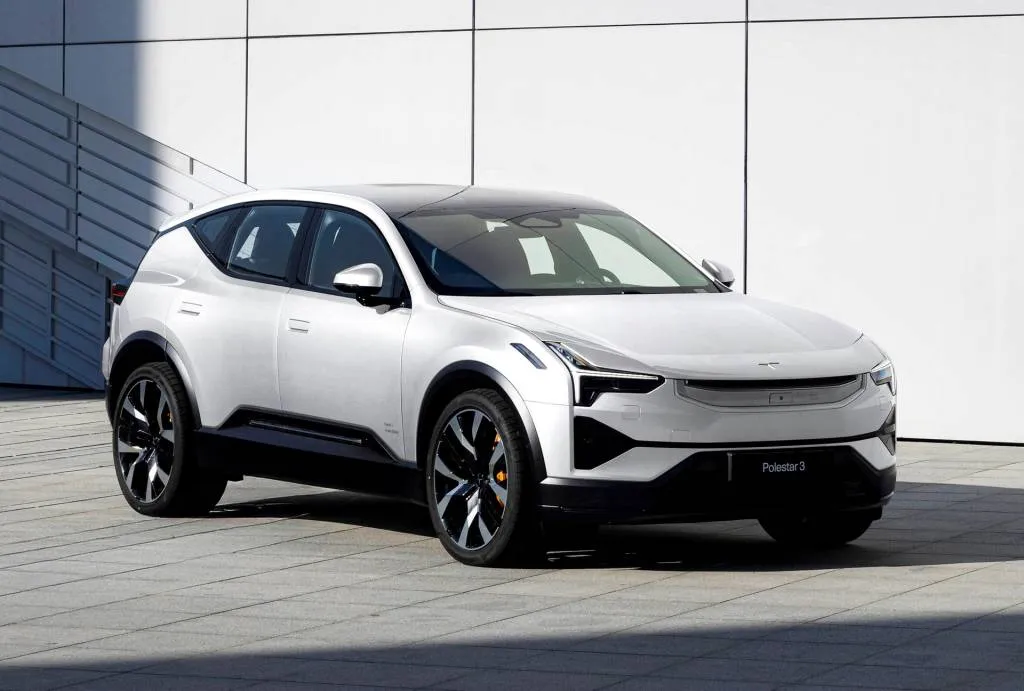
2025 Polestar 3
Additional funding was expected, but it’s still good news as Polestar looks to stabilize itself. Polestar shares have trended downward since the automaker went public in 2022 via a merger with a special purpose acquisition company (SPAC), and the automaker missed reduced 2023 delivery targets. Its 2024 financial results will be published in April.
Polestar describes itself as “born in Sweden,” although the EV maker produces most of its vehicles in China. It hasn’t manufactured a car in Sweden yet but leans on Volvo for development facilities. Thomas Ingenlath unexpectedly resigned as CEO of Polestar last year after leading the brand since its separation from Volvo, which had previously used the Polestar name for performance models, parts, and racing. Ingenlath was replaced in August of last year by Michael Lohscheller, who had previously served as CEO of Vinfast, Opel, and Nikola.
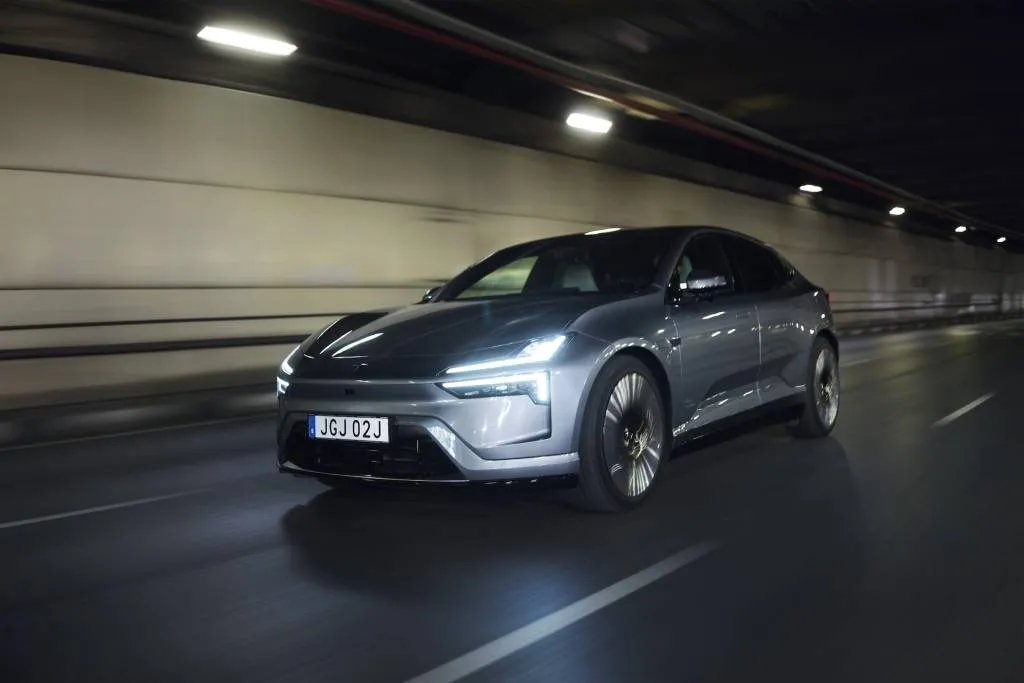
2025 Polestar 4
In what will likely help expand the brand’s reach, the Polestar 3 electric SUV went on sale last year, with U.S.-market vehicles manufactured in South Carolina. It likely has broader appeal than the Polestar 2 compact, or the segment-defying Polestar 4 that followed it to global showrooms.
The automaker reaffirmed in January that the Polestar 5 fastback would be the next model to arrive, reaching showrooms at some point later this year. It will be followed by a small SUV dubbed the Polestar 7, which will leapfrog the Polestar 6 convertible that’s also still in the queue.

Kia EV2 concept previews soulful small EV due in 2026
Kia on Thursday unveiled the Concept EV2, which previews an electric subcompact crossover expected to enter production in 2026.
Shown at the automaker’s EV Day presentation in Tarragona, Spain, alongside a handful of other electric vehicles, the boxy EV2 almost looks like an heir to the Kia Soul EV, which was sold in the U.S. in limited numbers from model years 2015 to 2019. A second-generation Soul EV was offered in other markets but it never made it to the U.S., even though it had an official 243-mile EPA range rating.

Kia Concept EV2
At 169.3 inches long, the EV2 is 4.1 inches longer than the current gasoline Kia Soul, and about the same length as the Kia EV3 electric crossover unveiled last May. That footprint puts both Kia vehicles between the Hyundai Kona Electric and Volvo EX30, two of the smaller EVs to reach the U.S., excepting the Fiat 500e that’s more than two feet shorter than the EV2.
Fanciful features like suicide doors (which Kia fully committed to by deleting the central roof pillar) likely won’t make it to production, but the flat floor, wide-opening tailgate, and pop-up cargo divider system might. The interior also features removable triangular speakers, a dashboard-spanning display, and the ability to project messages onto windows to communicate with other road users. Kia also claims to be developing an AI voice assistant for future EVs.
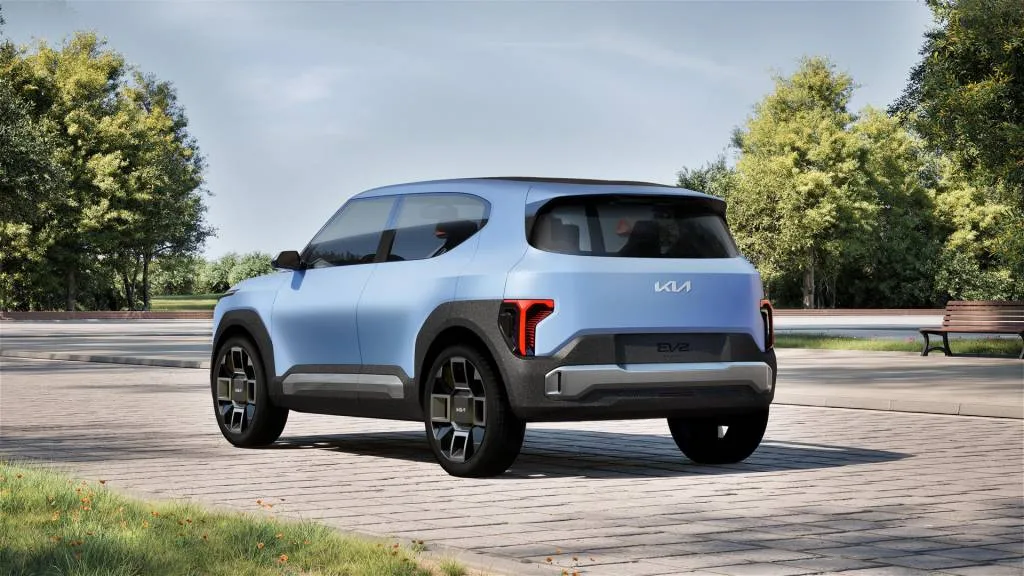
Kia Concept EV2
Kia has provided few technical details, but the EV2 is expected to use the same lower-cost version of the E-GMP dedicated EV architecture as the EV3. Cost-cutting is expected to include 400-volt charging in place of the 800-volt charging in other E-GMP models, although Kia said the EV2 will retain the bidirectional charging capability built into that platform.
The Concept EV2 was revealed alongside the production-ready EV4, a compact model to be offered in sedan and hatchback body styles, and the PV5 electric van. Kia has indicated that it’s mulling bringing the EV3 and EV4, as well as the PV5 van to the U.S., but it’s unclear if the EV2 might be sold here as well.

Stellantis and Rivian working on flat towing for EVs
Flat-towing an electric vehicle—that is, towing it with its wheels in contact with the road—is more difficult than with internal-combustion vehicles. But automakers are working on solutions.
When internal-combustion vehicles are flat-towed, their transmissions are shifted into neutral, or prop shafts are removed or disengaged, to allow the normally-driven wheels to rotate freely without risking damage to mechanical components. But mechanically decoupling electric motors from the wheels they normally drive isn’t as straightforward with EVs.
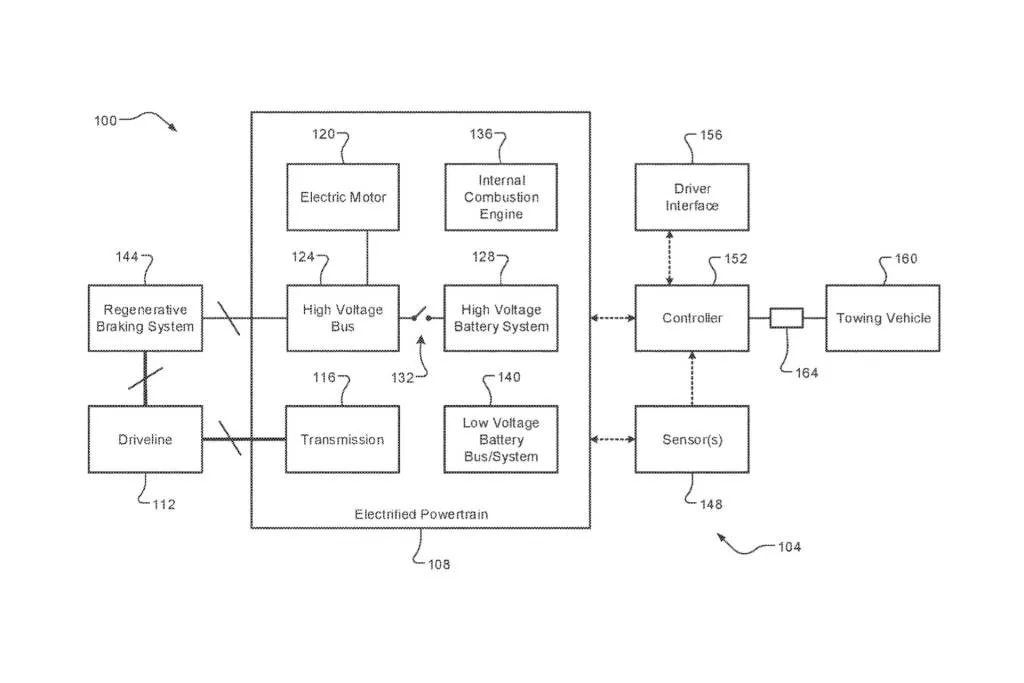
Stellantis EV flat towing patent image
In a patent filing published by the United States Patent and Trademark Office (USPTO) Jan. 30, 2025 (and submitted Jul. 24, 2023), Stellantis proposes an alternative, for vehicles equipped with permanent-magnet synchronous motors, at least. A high-voltage bus could be used to induce field weakening, reducing the torque of the motors and allowing them to spin more freely, while being isolated from the battery pack.
It’s a somewhat simpler solution than the one proposed by Rivian in a patent filing that surfaced just about a year ago. In that filing, the automaker discusses using software to disconnect the motor or motors that would normally power the rear axle, while still applying torque to the front wheels to keep the vehicle from rolling out of sync with the tow vehicle.

Rivian free-wheel towing patent image
In earlier patent application, published by the USPTO in 2021, Ford takes things a step further by suggesting that EVs could selectively be charged when towed. That also opens up the possibility of using the EV to help boost the tow vehicle up hills, similar to what startups Pebble and Lightship have built into travel trailers.
While flat-towing might not be a primary concern for all EV shoppers, it’s popular with RV owners, and could also make it easier to recover stranded EVs, reducing the need for flatbed trucks. So these patented ideas could prove quite useful if they’re ever applied to production vehicles.

Upcoming Nissan EV getting NACS port: Will it be next-gen Leaf?
- NACS will debut in Nissan-branded pure EV in 2025, be available in 2026
- Unclear whether that’s refreshed Ariya, or next-generation Leaf
- Nissan won’t immediately renew home charging around NACS
Nissan was the first Japanese automaker to confirm a switch to the Tesla-based North American Charging Standard (NACS) connector for future U.S.-market EVs.
It announced back in July 2023 that Nissan EVs with a NACS port would begin arriving in 2025, and in a recent check-in with Green Car Reports, Nissan confirmed that it remains on-track for that target—with a few intriguing details.
Nissan is now offering a NACS adapter for the Ariya, which has a CCS charge port, so that it can take advantage of the Tesla Supercharger network and other additional NACS connectors. That’s ahead of a message that Nissan is now adding a little more detail to: It confirmed Wednesday its plan to “introduce” a Nissan-branded pure EV with a native NACS port later this calendar year, with on-sale availability assured for calendar-year 2026.
That potentially pegs a refreshed Ariya as the first U.S. Nissan with a NACS port, but Nissan wouldn’t confirm that’s the case. Further, its hint of “introduce” opens the door to a different model potentially leading the transition, at least from a show stand. A next-generation Nissan Leaf is likely to be previewed globally before the end of the year, for instance, but its U.S. arrival and timing are unclear as of yet.
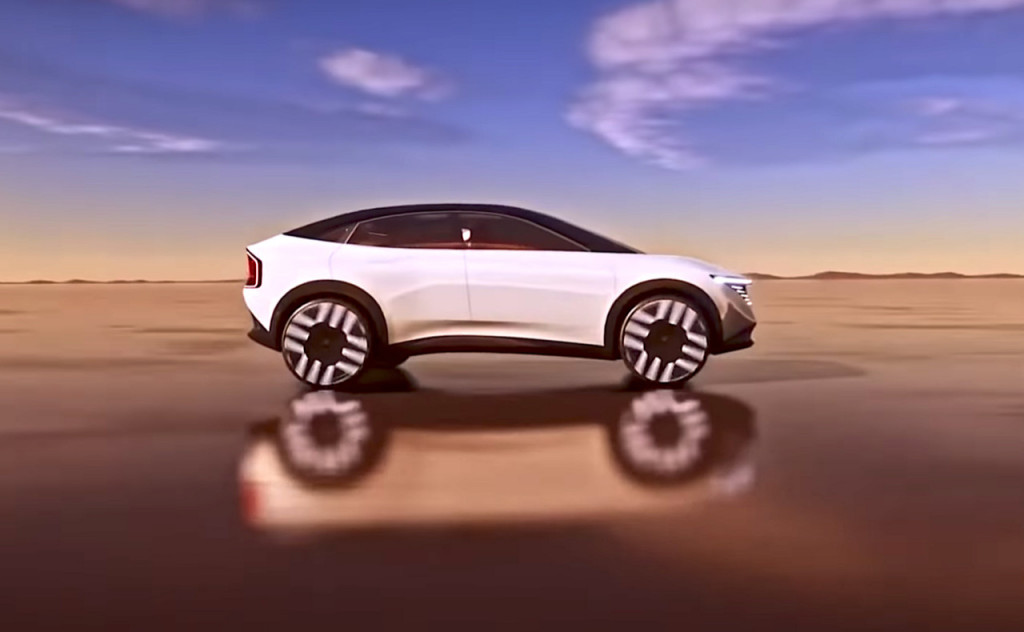
Nissan Chill-Out concept – December 2021

Nissan Chill-Out concept – December 2021

Nissan Chill-Out concept – December 2021
In advance of this, Nissan updated its app earlier this year so that you can now see live station availability, compatibility with your vehicle, and what equipment is needed to achieve the peak charge rate. You can also start and stop charging sessions—even those on the Supercharger network—with the app.
To prepare for the adapters and then that bigger shift, Nissan already has all compatible Supercharger stations listed in the Nissan app, according to Ansu Jammeh, an engineer overseeing charging compatibility and development at Nissan in the U.S.

Nissan app – network filters including Tesla Supercharger
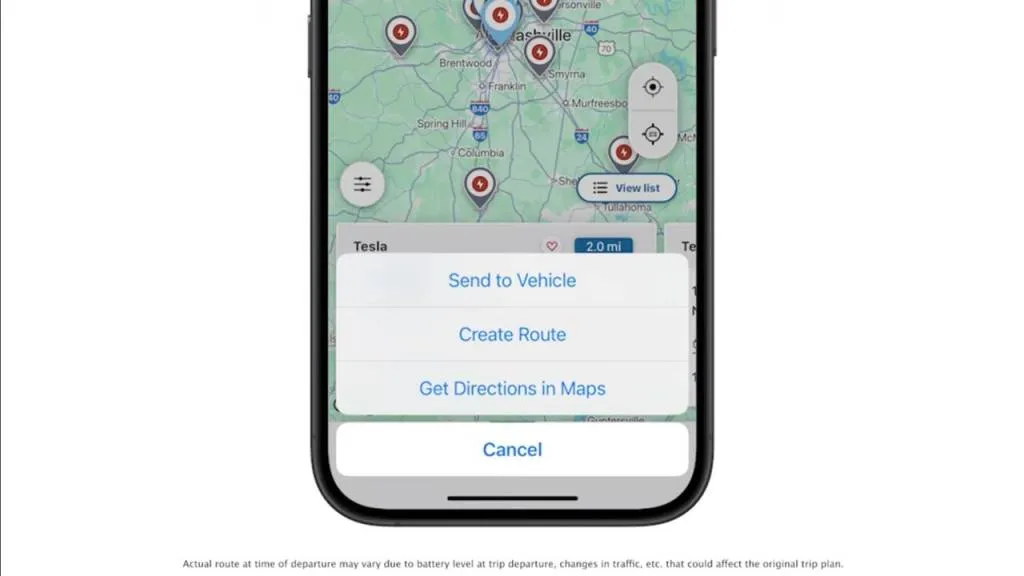
Nissan app — ability to send Tesla Supercharger guidance to vehicle
With NACS compatibility, Nissan added an additional 20,000 DC fast-charger posts. That essentially doubles the charge connectors available to a Nissan customer, Jammeh recently noted to Green Car Reports.
Regardless of what happens with a range of factors such as the federal charging buildout, Nissan is expecting “steady growth” in U.S. charging infrastructure over the next few years, according to Jammeh. “Industry-wide, we still see the customer want, and the necessity, behind more charging infrastructure,” he underscored.
Home charging remains a big part of it, too, and Jammeh emphasized that part of it won’t be changing immediately—and it doesn’t need to, with adapters playing their part.

Nissan Ariya at Tesla Supercharger station
“The beautiful part is that, between J1772, CCS1, and NACS, they’re compatible,” said Jammeh, referring to what’s assured by the developing J3400 standard around the NACS connector. “So in terms of a customer, do they actually need to change their home infrastructure? No, they can utilize the same equipment they have.”
As for that adapter, it’s available now, and it can be purchased for $235 through Nissan dealers or directly from Nissan.
Nissan strongly advises against using a third-party adapter—or for that matter, even the Tesla Magic Dock, and cautions that it’s prohibited under Nissan’s own terms and may also violate Tesla’s terms of use for the Supercharger Network. In Nissan’s design specifically, a plastic tab that fits within the adapter helps it fit securely.
The adapter fully supports the Ariya’s peak charge rate of 130 kw, which allows it to charge from 10-80% in as little as 35 minutes, according to Nissan.

2023 Nissan Ariya at EVgo charging station
Jammeh said that looking ahead, Nissan “will support any change that needs to be done on the vehicle design or equipment side to make sure customers are best-equipped.” But the engineer couldn’t yet say whether or not that means better support in its electric vehicle products for bidirectional charging—just that it hopes to adopt those technologies in the future.
Future charging technology announcements, Jammeh hinted, might also correspond with Nissan’s plans to offer an all-solid-state battery in at least one global vehicle by 2028.
Nissan, on a global basis, has emphasized the importance of bidirectional charging tech, including vehicle-to-home (V2H) and vehicle-to-grid (V2G) technologies, and it once said those capabilities were built into the Ariya. In the U.S., Nissan does support Leaf bidirectional charging, but the only compatible (and warranty-supported) unit at present is one that enables V2G rather than home-backup capability.
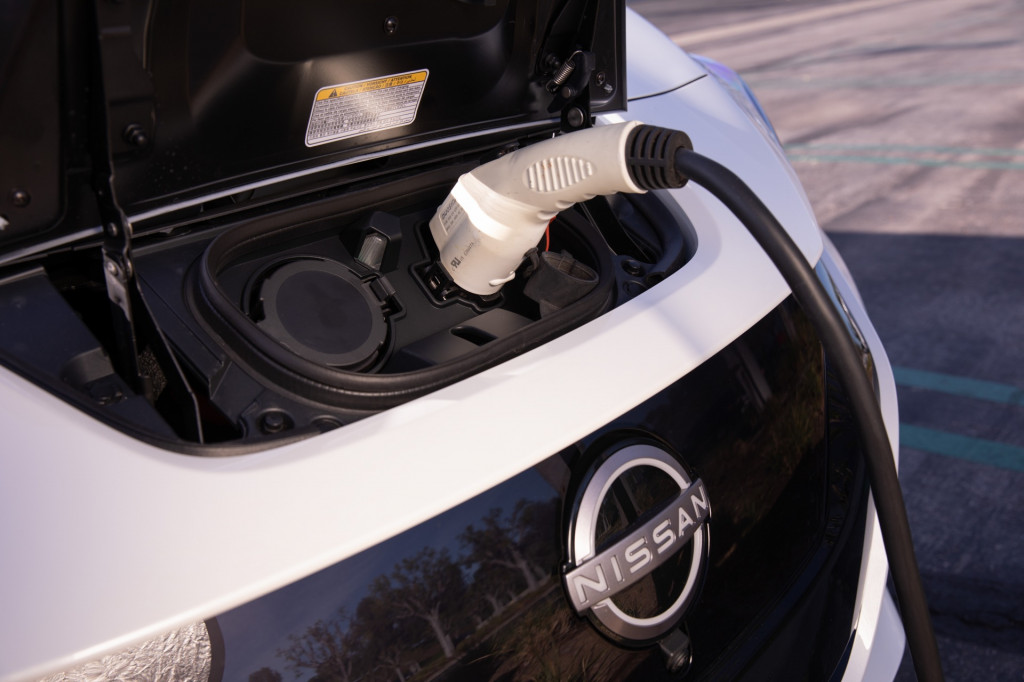
2023 Nissan Leaf
The Leaf is Nissan’s only U.S. vehicle to use the CHAdeMO charge port. A 2026 Nissan Rogue plug-in hybrid has also been confirmed, and seeing that its Mitsubishi Outlander PHEV cousin uses CHAdeMO, it will be interesting to see whether it arrives with that, CCS, or NACS. Nissan also has several Mississippi-made EVs in the works, but those have now been pushed out to 2028 and will surely offer NACS.
In the meantime, with such variance in upcoming EVs, adapters, and different charge ports, it’s going to be much more of a challenge for automakers to communicate what to plug into—both within apps and in-person.
